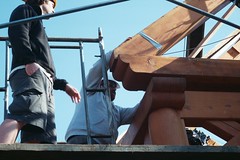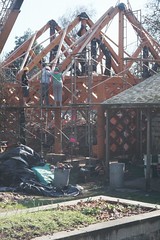Thursday, April 27, 2006
Monday, April 17, 2006
Majolica Overview
Majolica Overview
|
Majolica Overview | Majolica Recipes | Majolica Bibliography
What is majolica?
Majolica in the historic sense is earthenware with a white, tin-opacified,
viscous glaze, decorated by applying colorants (often with a brush, using
calligragphic brush work) on the raw glazed surface. The viscosity of the
glaze restricts flow as the glaze melts, giving a glossy surface that
maintains the line quality of the surface decoration.
A condensed history:
Tin-glaze earthenware began in the Middle East. When people there
became a political force they conquered northern African and came
across Gibraltar into Spain, and brought this ceramic knowledge with
them. Spanish potters then made Muslim-inspired works in this method.
Italians imported this ware from the Spanish port of Majorca, calling it
majolica ware. When the French imported it from Faenza, they called it
faience. When the Dutch became proficient with these techniques and
exported quantities of ware from Delft, it was called Delftware. Some
confusion exists, as "majolica" and "faience" are sometimes also used to
describe a method of using bright, transparent lead glazes over relief
ware, like that produced by the Minton Co. in England in the 19th century.
This is a different usage, thought to originate because the bright colors
of the transparent lead glazes reminded the makers of Italian majolica.
This glaze is smooth, white, and opaque. Colorants are usually applied in
a thin wash to the raw glaze surface. Does not move in firing. May crawl
if thick in corners, or may pinhole over rough-trimmed surfaces. Fire
w/small 03 cone in the sitter to give a small 04 tipped to about 2 o'clock
in front of the peep hole.
Majolica Glaze cone 04-03
Frit 3124 65.75
F-4 feldspar 17.24
kaolin 10.82
neph sy 6.24
tin 5
zircopax 10
bentonite 2
Dash of epsom salts helps counter settling.
Majolica colorant suggestions: Mix colorants by VOLUME with flux. I use gerstley
oxides in suspension and adds better brushability than using frit (Frit 3124
is used by many majolica artists, and liquid laundry starch used to aid
suspension).
Colorants that melt well at low-fire temperatures are mixed 1 color to 1
gerstley borate (e.g. copper, cobalt, iron). More refractory oxides and
most glaze stains are mixed 1 part colorant + 3-4 parts gerstley borate.
Stains that are very refractory and primarily used as body stains (to color
clays or slip) will give a rough, pig-skinned surface, even when mixed 1:4
(e.g. Mason 6020 pink). While this may be an interesting effect if planned,
it can be an unhappy surprise.
Majolica Colorant Hit Parade
yellow: (non-lead): Drakenfeld 41545
yellow: (lead: DO NOT USE INSIDE FOODWARE): Drakenfeld GS758
pink: Mason Alpine Rose 6001
coral: Harshaw E-303 Coral
pumpkin: rutile
blue: Mason 6300 Mazerine or Vivid Blue w/a dash of cobalt
turquoise: O'Hommel TU-96
soft blue-green: copper green
opaque grass green: chrome green
purple: Standard K-42 Orchid
crimson: Standard K-24 Maroon or Mason Deep Crimson 6006
grey: O'Hommel 2B 9886
mint: Mason Bermuda Green 6242
chartreuse: mix wet (already mixed w/gerstley borate) 2 parts Drakenfeld
41545 or bright praseodymium yellow with 1 part copper
black: black stain or mix (by weight) 20 iron oxide + 15 cobalt + 10 manganese +
5 chrome & use like stain
Advantages of Majolica
- The viscous glaze does not move when fired: brush work stays crisp, no
runny glaze to chip off shelves, dry-footed areas need less margin on pot
bottoms or lid seats. - Thick glaze blankets the piece: forgives small handling errors on clay.
- The kiln is a passive tool: results are more predictable firing-to firing.
Someone else could fire your work and achieve the same results (easier
to share kilns). - Inexpensive color: it takes less colorant to put a thin wash of color on
the glaze surface than to color a slip or a glaze. - Bright color: stains provide a range of pinks, yellows,
oranges, yellows, purples that work well with the blue, green, and rust
available with oxides.
Disadvantages of Majolica
- The viscous glaze does not move when fired: lumps and drips in
application remain, pin holes, etc. do not heal over in firing, and thick
glaze may crawl. - Thick glaze blankets the piece: may cover small details in clay handling.
- Kiln is a passive tool: color is uniform and may look flat, does not
describe the form. No gifts from the kiln gods. - Bright color: may look garish or entire palette may look too pastel and
lose impact.
If you don't find the exact shade of stain that pleases you in the
widely-available Mason offerings, several companies offer options.
Columbus Clay (Columbus, OH, (614) 294-1114) has some stains from
industrial manufacturers in addition to Mason colors. Standard Ceramics
(Pittsburgh, PA (412) 276-6333) offers their own line of stains. You can
order from Standard, or a local distributor selling Standard products can
order them for you (e.g.Southern Pottery, Baton Rouge, LA (504)
752-7687). A.R.T. Studio Clay Co. (Elk Grove Village, IL (800)323-
0212) offers Degussa stains from Germany in addition to Mason. Most will
sell small test amounts for trial with your glaze materials.
Palette selection is relative and involves personal choices. All the Josef
Albers color studies that apply to painting apply here as well. A color that
looks pale as a test may look better next to its complement or mixed with
an analogous color. Color that seems too flat may be varied by "loading"
the brush with more than one color so that it will modulate in the brush
stroke.
Colors can also be mixed before applying (testing is advised), or can be
layered (most are at least somewhat translucent).
Glaze application is important because the glaze does not move in firing.
Lumps and drips can be sanded with fingers or fine (e.g.#400) sandpaper.
Remove dust with a soft brush or a barely damp clean sponge before
decorating.
Applying color with a brush to raw glaze is like doing watercolor on blotter
paper. The direction and speed of the brush show in the mark.
Background color may be applied with built-up strokes to make a visual
texture, or motifs may be sealed with wax resist and the ground color brushedove
top of wax resist should be sponged off unless you want the dots of color
in the finished work).
Often majolica has problems with pin-holing. Trimmed areas that are not
ribbed smooth after trimming may cause this problem. Dampen bisque
before dipping in glaze to reduce air pinholes in the raw glaze. Rub with
a finger to fill pinholes in the raw glaze.
White dotting in colored areas is another common problem.
Ceramics Monthly has answered this twice and suggested zirconium in
the glaze gassing in firing and/or materials in the clay body releasing
gasses during firing. Whatever the source, I've found more problems on
pieces with thicker glaze and work that was fired quickly. If you fire very
slowly, however, the color may start to break up or sink into the molten
glaze and look faded.
My thanks to other majolica artists who have shared their information
through the ceramic grapevine and intrigued me with their work. A partial
list includes Stan Andersen, Mary Jo Bole, Bill Brouillard, Bruce
Cochrane, Deirdre Daw, Kathy Ervin, Andrea Gill, Deby Groover,
Jane Gustin, Walter Ostrom, Terry Siebert, and Tornado Fish Camp (Gina
Bobrowski and Triesch Voelker).
Here's to the challenge of working within constraints.
Author information:
Linda Arbuckle
Rt.1 Box 206
Micanopy, FL 32667
(904) 466-3520
Univ. of Florida
Department of Art: Ceramics
302 FAC
Gainesville, FL 32611-2032
(904) 392-0228





